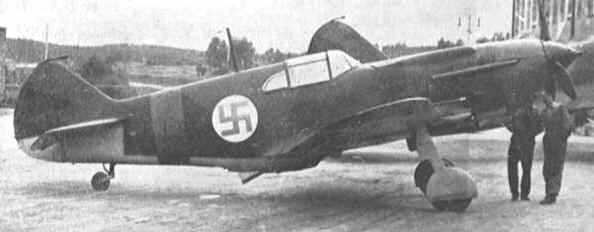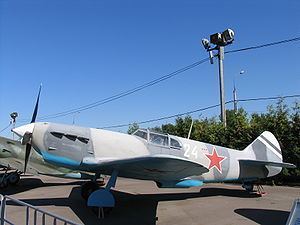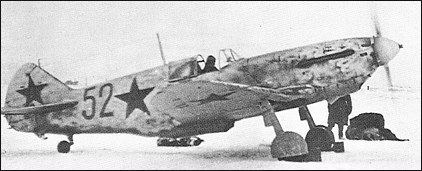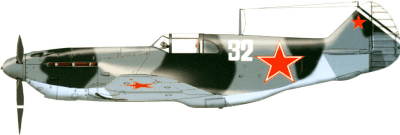Top speed 575 km/h Length 8.81 m Engine type Aircraft engine Manufacturer Lavochkin | Wingspan 9.8 m Introduced 1941 First flight March 30, 1939 | |
 | ||
Il2 lavochkin gorbunov gudkov lagg 3
The Lavochkin-Gorbunov-Gudkov LaGG-3 (Лавочкин-Горбунов-Гудков ЛаГГ-3) was a Soviet fighter aircraft of World War II. It was a refinement of the earlier LaGG-1, and was one of the most modern aircraft available to the Soviet Air Force at the time of Germany's invasion in 1941.
Contents
- Il2 lavochkin gorbunov gudkov lagg 3
- Design and development
- Operational history
- Variants
- Operators
- Specifications LaGG 3 data for LaGG 3 series 66
- References

Overweight despite its wooden construction, at one stage 12 LaGG-3s were being completed daily and 6,528 had been built when factory 31 in Tbilisi switched to Yak-3 production in 1944.

Design and development

The prototype of the LaGG-3, I-301, was designed by Semyon A. Lavochkin, Vladimir P. Gorbunov and Mikhail I. Gudkov. It was designated LaGG-3 in serial production. Its airframe was almost completely made of wood delta-veneer (a resin-wood multi-ply veneer composed of very thin, 0.35 to 0.55 mm, wood veneer and phenol formaldehyde resin, baked at high temperature and pressure) used for the crucial parts. This novel construction material had tensile strength comparable to that of non-hardened aluminum alloys and only 30% lower than that of precipitation hardened D-1A grade duralumin. It was also incombustible and completely invulnerable to rot, with service life measured in decades in adverse conditions. The full wooden wing (with plywood surfaces) was analogous to that of the Yak-1. The only difference was that the LaGG's wings were built in two sections. The fuselage was of similar construction to the MiG-3's. The LaGG-3's armament consisted of a 20 mm ShVAK cannon, with 150 rounds, which was installed in the motornaya pushka in the cilinder block split- between the "V" of the engine cylinders and firing through a hollow propeller shaft, and two synchronized 12.7 mm Berezin UBS machine guns with 170 rpg. Consequently, the combined weight of rounds fired per second was 2.65 kg/s, making the LaGG-3 superior in burst mass to all contemporary Russian fighters, particularly to the MiG-3. Most other Russian fighters of that era were considered under-gunned in relation to western contemporary fighters. This is somewhat true even for the Yak-1, which had a 20 mm cannon and two 7.62 mm machine guns, but not the later versions of the Polikarpov I-16, which had two cannons and two machine guns.
Operational history

The LaGG-3 rapidly replaced the LaGG-1, although the new fighter was too heavy for its engine. In fact, Lavochkin, Gorbunov and Gudkov had originally designed their prototype for the powerful Klimov M-106 engine, but it proved to be unreliable, so they were obliged to install the relatively weak Klimov M-105P. As a result, the LaGG was slow; its top speed was just 575 km/h, while its rate of climb, at ground level, was as slow as 8.5 meters/second. The LaGG-3 proved to be somewhat hard to control as it reacted sluggishly to stick forces. In particular, it was difficult to pull out of a dive, and if the stick was pulled too hard, it tended to fall into a spin. As a consequence, sharp turns were difficult to perform. A more powerful version of the engine was installed, but the improvement was small, so the only solution was to lighten the airframe. The LaGG team re-examined the design and pared down the structure as much as possible. Fixed slats were added to the wings to improve climb and maneuverability and further weight was saved by installing lighter armament (most versions used a 20 mm ShVAK cannon and a single synchronized 12.7 mm Berezin UBS machine gun). But the improvement was slight and, thus, without an alternative powerplant, when the LaGG-3 was first committed to combat in July 1941, it was completely outclassed by the Messerschmitt Bf 109.

Later in 1941, the LaGG-3 appeared with new armament options, an internally balanced rudder, retractable ski landing gear for the winter, retractable tailwheel and wing pipes for drop tanks. The result was still not good enough. Even with the lighter airframe and revised supercharged engine, the LaGG-3 was underpowered.
The LaGG-3 proved immensely unpopular with pilots. Some aircraft supplied to the front line were up to 40 km/h (25 mph) slower than they should have been and some were not airworthy. This happened less because of the added weight with full fuel and weapon loads in combat conditions, but specifically to the poor finishing in rushed industrial production, due to the German invasion. In combat, the LaGG-3's main advantage was its strong airframe. Although the laminated wood did not burn, it shattered when hit by high explosive rounds.
The LaGG-3 was improved during production, resulting in 66 minor variants in the 6,528 that were built. Experiments with fitting a Shvetsov M-82 radial engine to the LaGG-3 airframe finally solved the power problem, and led to the Lavochkin La-5. The major LaGG-3 construction plant in Gorky switched over to the La-5 in 1942, after having completed 3,583 LaGG-3. All further LaGG-3 development and production was done by factory 31 in Taganrog as the sole LaGG-3 manufacturer.
Soviet pilots generally disliked this aircraft. Pilot Viktor M. Sinaisky recalled:
It was an unpleasant client! Preparing the LaGG-3 for flight demanded more time in comparison with other planes. All cylinders were supposed to be synchronized: God forbid you from shifting the gas distribution! We were strictly forbidden to touch the engine! ... [T]here were constant problems with [the] water-cooled engines in winter.... [T]here was no anti-freeze liquid [and y]ou couldn't keep the engine running all night long, so you had to pour hot water into the cooling system ... in the morning. ... [P]ilots didn't like flying the LaGG-3 – a heavy beast with a weak ... engine... [T]hey got used to it ... [but] we had higher losses on LaGG-3 than on I-16s.Even with its limitations, some Soviet pilots managed to reach the status of ace flying the LaGG-3. G. I. Grigor'yev, from 178th IAP, was credited of at least 11 air victories plus two shared. But pictures of his LaGG-3 "Yellow 6", in November–December 1941, show 15 "stars", so his score was probably higher.
Variants
Operators
Specifications LaGG-3 (data for LaGG-3 series 66)
Data from Jane's Fighting Aircraft of World War II
General characteristics
Performance
Armament
